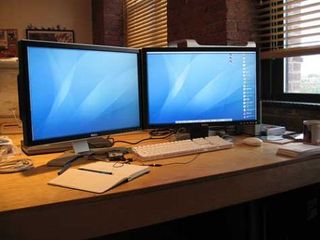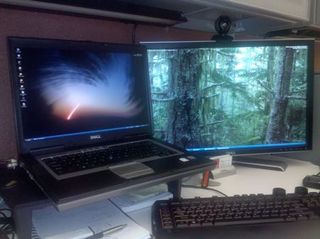Tips For The Multi-Display Life
Thinking about adding a second monitor to your desk? Here are reasons to take the plunge, and options to consider while shopping and setting it up.
Multiple Displays and Productivity

Anyone who has felt the rush of excitement that comes with placing an extra display on his desk, connecting it to the computer, and turning it on will tell you: The first thing you learn to appreciate with a second monitor is the sheer increase in real-estate that you have to work with. It doesn’t take longto start spreading out icons, widgets, and windows so that more things can be seen at the same time without having to flip through applications and windows to go from a Word to a useful browser window. Don’t be afraid to move some of your icons or shortcuts from your primary display to the new one. Adding a second monitor gives you plenty of room to stretch out and place icons and widgets all over your screen, instead of letting them all bunch up on the left side of your primary display.
Depending on the kind of work you do and the applications you most commonly use, you’ll want to tailor the setup of your two displays.
Photo and video editors, who, for example, do a lot of video editing in Final Cut Pro or Adobe Premiere, or spend all day doing graphic design in Photoshop or InDesign, would find it helpful to have the main working application maximized in one display while secondary apps including e-mail, a Web browser, or instant message apps are opened in the second monitor.
This way, the editor can glance over at those secondary apps without having to stop what he’s doing and bring another app to the front.

Web developers and desktop publishers may be interested in a display that easily rotates into a portrait view. Some monitors and most graphics drivers support the ability to rotate a wide-screen display to a vertical portrait mode, perfect for editing long documents or sorting through pages and pages of code.
These examples are supported by actual research. A study conducted by the Office21 research project in 2008 showed that one of the best ways to improve worker productivity is to add displays to each workstation. By adding larger displays, you can measurably increase a person’s speed and output while working, and the study showed that workers using a 19-inch display had a harder time accomplishing the same tasks as someone with a 22” display.
Additionally, adding more displays can increase productivity by up to 35%, according to this research. The study added two, then three monitors to a single user’s workstation and measured how long it took a group of 67 people to accomplish the same set of tasks with single, dual, and then triple displays. The study concluded that multiple displays were best suited to people who need to absorb and process digital information rapidly, like scientists, editors, and engineers: anyone who has to sit work at a computer for long periods of time. In the Internet era, we think that applies to almost everyone.
Sign up to get the BEST of Tom's Guide direct to your inbox.
Get instant access to breaking news, the hottest reviews, great deals and helpful tips.

Increased work productivity isn’t the only benefit to having more than one display. Gamers will find that once they experience a favorite game in windowed mode—allowing them to answer instant messages, check e-mail, or even research the game on the Web during downtime, they’ll never go back to one monitor.
For example, World of Warcraft players frequently ”tab out” to read strategy guides on the Web, compare items, or use voice chat to communicate with friends. With more than one display, gamers do all of those things without taking their eyes off of the action. The same applies for full-screen video; there’s no reason to stop working in one display to play a movie in the other.
No matter your task, you can probably find a way to improve your experience with more than one display. Even if you spend your days doing nothing more complex than editing documents and surfing the Web, it’s helpful to have the ability to move windows around. Some people prefer to put work in one window and reference material in another window, or to put all “work” apps on one maximized window, and other apps like e-mail, IM, Twitter client, or desktop widgets on the other display. How you arrange your apps is up to you and how you feel comfortable using the space.
In fact, one of the best things about having more than one display on your desk is that you have the freedom to experiment with the way your windows and icons are laid out, and the placement of the monitors on your desk, so that you can determine the best orientation and layout for the way you work and play.
Current page: Multiple Displays and Productivity
Prev Page Tips For The Multi-Display Life Next Page Choosing the right display for your space and needs-
cadder I run CAD and have 2 22" 16:10 displays on my desk. This is almost too much width, it sacrifices open space on each side that I would use to lay large documents for reference.Reply
If you already have one monitor and you want to buy a second one, first measure your space, second measure the height and width of your current monitor. It might look funny if you have a 4:3 monitor that is fairly tall and you buy a widescreen that ends up being wider but not quite as tall. But I think it would be OK if the new widescreen is taller. Also be prepared to have different colors between the 2 monitors. One might look a bit blue compared to the other one for instance, and it might be difficult to match the brightnesses between them. If possible buy 2 matching monitors and replace what you already have.
Of course always check that your computer has ports for connection of 2 monitors. Older PC's will have 15-pin VGA connectors, newer PC's will probably have the rectangular DVI connectors, or even HDMI. Monitors will come with different types of inputs, and possibly with a variety of cables and/or adapters. If you know what you have then when you buy your monitors you can be sure they will work right away without needing another trip to the store for new cables and/or adapters. -
socalboomer Dual monitors is also very inexpensive - dual 17" monitors can greatly increase your real estate and your productivity for very little money (17" monitors are CHEAP).Reply
Personally, I use four, stacked 2x2, and it is amazing. One is dedicated to email, one to other email plus calendars and utilities, one is for terminal windows (to servers) as well as general work, and a wider monitor is there for general purpose. Amazing - and go back to even dual monitors is really limiting!
One little note - for more than two monitors, you're going to need a second video card (or a single ATI) - make sure your computer will handle it (likely need dual PCIx16 slots, at least physical slots) - but oh it's worth it! -
liquid0h My office at work uses dual screens. I remember when we first got them, we thought it might have been a waste of money. But going on 3 years now and we haven't looked back. Working with multiple Excel sheets or Access tables is a breeze now.Reply -
m-manla I'm planning to replace my old 22" 16:10 monitor in for two 22" 16:9 monitor. I have worked on dual screens in different occasions and there is nothing like it.Reply -
tommysch As a gamer I run a 24" 1920*1080 main screen and a 19" 1280*1080 secondary screen. Its particularly useful when playing a FPS competitively. You can have your GPU temp, CPU temp, ping to many references, bandwidth monitor, vent/mumble/TS always in sight, core usage, RAM usage and messenger while playing a full screen game. I dont even use my G15 screen anymore.Reply -
skpman thanks TH! i was really looking for the software that gives you dual taskbars... just bought Ultramon! loving itttReply
BTW my work sucks. us engineers are using 17" (yeah, seriously) monitors. I bought my own secondary because it was getting so frustrating. My 26" at home is more than enough for my personal needs...
On a related note.. anyone from TH know about this product:
http://www.soundgraph.com/fingervu706-feature-en/
-
ds1495 Oops, just noticed a minor little spelling error in the article. When it says: "If so, are three monitors better than too that should be spelled two :PReply
Anyways, nice article, I have been looking into getting a second monitor for a while now, perhaps I'll take the plunge now. -
JohnnyLucky Thank you for a very informative article . Ever since I built my new pc 3 months ago I've been wanting to get mutiple monitors for both work and play. The article cleared up some questions I had about monitor and desk sizes. Turns out I was right in thinking my 23 inch deep desk would be too shallow for what I want.Reply -
volks1470 hooray for me, I just took the plunge a week ago. ATI makes a multi-monitor setup such a breeze. I love bezel compensation!Reply
Most Popular

